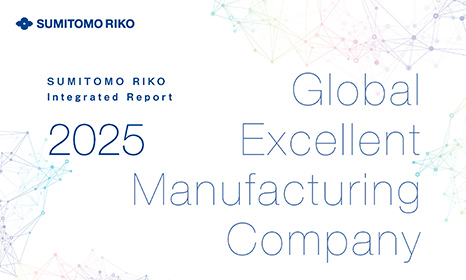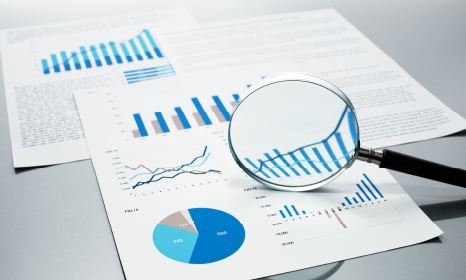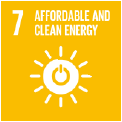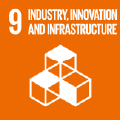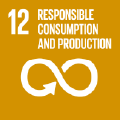Responding to Climate Change
Environment (E)
- Long-Term Environmental Vision and Environment 2029V
- Environmental Management
- Responding to Climate Change
- Responding to Water Risks
- Contributing to a Resource-Recycling Society
- Contributing to a Society in Harmony with Nature
- Appropriate Chemical Substance Management
- Environmental Communication
- Environmentally Friendly Products
Shareholders and Investors, Suppliers and Other Trade Partners, Local Communities, Global Environment
Basic Approach
The Sumitomo Riko Group is committed to achieving carbon neutrality by 2050 and has established greenhouse gas (GHG) reduction targets. We are dedicated to reducing our CO2 emissions (Scopes 1 and 2) and those throughout our supply chain (Scope 3) as part of a unified company-wide effort.
To minimize direct emissions, we are adopting a dual approach that includes transitioning to renewable energy sources and reducing energy consumption during production. By leveraging our core strengths in manufacturing, materials, and product development, we are actively working to mitigate and adapt to climate change. In addition, we are implementing initiatives in our supply chain to reduce CO2 emissions associated with the sourcing, transportation, and disposal of raw materials and components.
To minimize direct emissions, we are adopting a dual approach that includes transitioning to renewable energy sources and reducing energy consumption during production. By leveraging our core strengths in manufacturing, materials, and product development, we are actively working to mitigate and adapt to climate change. In addition, we are implementing initiatives in our supply chain to reduce CO2 emissions associated with the sourcing, transportation, and disposal of raw materials and components.
SBTi Validation of Our Targets
In April 2021, the GHG emission reduction targets of the Sumitomo Riko Group, as part of the Sumitomo Electric Group, were validated by the Science Based Targets initiative (SBTi). These targets aim for a 30% reduction in Scope 1 and 2 emissions by fiscal year 2030 and a 15% reduction in Scope 3 emissions, both based on FY2018 levels. These goals align with the Paris Agreement’s objective of limiting global temperature rise to well below 2℃ (WB2℃) above pre-industrial levels.
Given the urgent need for greater efforts to reduce GHG emissions, as emphasized in the AR6 Synthesis Report: Climate Change 2023, published by the Intergovernmental Panel on Climate Change (IPCC) in March 2023, we recognize the importance of more ambitious actions. As part of our Environment 2029V initiative, introduced in 2023, we have advanced the target achievement year by one year with the 1.5℃ target in mind.
Given the urgent need for greater efforts to reduce GHG emissions, as emphasized in the AR6 Synthesis Report: Climate Change 2023, published by the Intergovernmental Panel on Climate Change (IPCC) in March 2023, we recognize the importance of more ambitious actions. As part of our Environment 2029V initiative, introduced in 2023, we have advanced the target achievement year by one year with the 1.5℃ target in mind.
Disclosure on Climate Change Response
In June 2022, the Sumitomo Riko Group publicly expressed its support for the Task Force on Climate-related Financial Disclosures (TCFD) recommendations and is committed to providing transparent information through our securities reports, integrated reports, website, and other channels.
In the future, we will continue to enhance the quality of our disclosures in alignment with international sustainability disclosure standards, including the International Sustainability Standards Board (ISSB) guidelines.
In the future, we will continue to enhance the quality of our disclosures in alignment with international sustainability disclosure standards, including the International Sustainability Standards Board (ISSB) guidelines.
Related Information
Medium- and Long-Term GHG Reduction Targets
| Item | Target Year | CO2 Reduction Targets |
|---|---|---|
| Sumitomo Riko Group Long-Term Environmental Vision 2050 | 2050 | Achievement of Carbon Neutrality |
| 2029 Sumitomo Riko Group Vision (2029V) | FY2029 | Scope 1+2: 30% reduction compared to FY2018 Scope 3: 15% reduction compared to FY2018 |
|
2025 Sumitomo Riko Group Medium-term Management Plan (2025P) |
FY2025 | Scope1+2: 20% reduction compared to FY2018 |
Efforts to Reduce GHG Emissions in Business Operations
The Sumitomo Riko Group is committed to achieving carbon neutrality by 2050. We are enhancing energy productivity by rigorously reducing energy loss and implementing initiatives to turn off equipment when it is not in use, while also upgrading inefficient energy systems to improve our infrastructure. Additionally, we are promoting the adoption of renewable energy sources, such as solar power, to reduce our GHG emissions.
GHG Emissions (Sumitomo Riko Group)
The Sumitomo Riko Group has achieved a 29.3% reduction in total GHG emissions for FY2024 compared to FY2018, while carbon intensity has decreased by 47.9% over the same period.
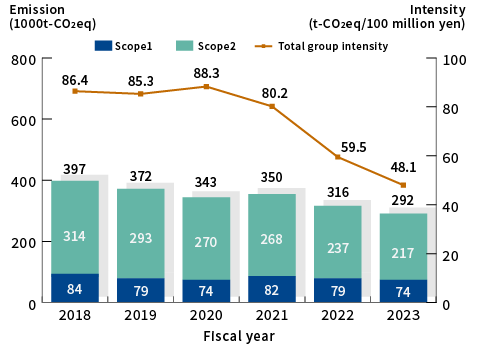
*1 The denominator used to calculate the intensity is net sales (after eliminating internal transactions) within the aggregation scope.
*2 Starting from FY2023, we have switched the CO2 emission factors for electricity from a location-based approach to a market-based approach. We are utilizing emission factors specific to electricity providers, and in some cases, we also use country-specific factors from the IEA Emissions Factors.
*3 The CO2 emission factors for sources other than electricity are based on the factors outlined in the Manual for Calculation and Reporting of Greenhouse Gas Emissions published by the Ministry of the Environment.
*4 Starting from FY2023, the emission factors have been revised due to changes in the Act on Promotion of Global Warming Countermeasures.
*5 The emissions data presented in this section has been assured by a third-party organization. However, the emission intensity figures are not included in the scope of this assurance.
*2 Starting from FY2023, we have switched the CO2 emission factors for electricity from a location-based approach to a market-based approach. We are utilizing emission factors specific to electricity providers, and in some cases, we also use country-specific factors from the IEA Emissions Factors.
*3 The CO2 emission factors for sources other than electricity are based on the factors outlined in the Manual for Calculation and Reporting of Greenhouse Gas Emissions published by the Ministry of the Environment.
*4 Starting from FY2023, the emission factors have been revised due to changes in the Act on Promotion of Global Warming Countermeasures.
*5 The emissions data presented in this section has been assured by a third-party organization. However, the emission intensity figures are not included in the scope of this assurance.
Energy Consumption (Sumitomo Riko Group)
The total energy consumption of the Sumitomo Riko Group for FY2024 decreased by 7.6% compared to the previous year.
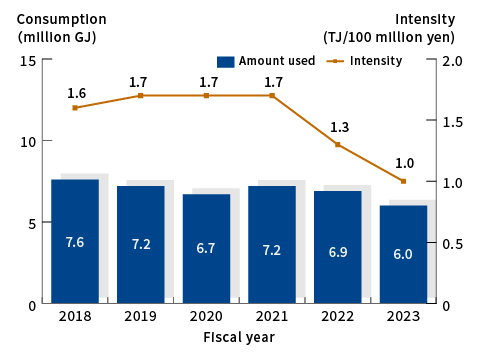
*1 The emission intensity figures are not included in the scope of the third-party assurance.
*2 The denominator used to calculate the intensity is net sales (after eliminating internal transactions) within the aggregation scope.
*3 The energy conversion factors used are based on the Act on the Rational Use of Energy (Energy Conservation Act) by the Ministry of Economy, Trade and Industry of Japan.
*4 In FY2023, the energy conversion factors were revised due to amendments to the Energy Conservation Act.
*2 The denominator used to calculate the intensity is net sales (after eliminating internal transactions) within the aggregation scope.
*3 The energy conversion factors used are based on the Act on the Rational Use of Energy (Energy Conservation Act) by the Ministry of Economy, Trade and Industry of Japan.
*4 In FY2023, the energy conversion factors were revised due to amendments to the Energy Conservation Act.
Renewable Energy Consumption (Sumitomo Riko Group)
The Sumitomo Riko Group's renewable energy consumption for FY2024 has increased by 50% compared to the previous year, and the ratio of renewable energy has risen by 6.2 percentage points.

* Renewable energy ratio = Renewable energy electricity consumption / Total electricity consumption
To achieve carbon neutrality, the Sumitomo Riko Group is actively advancing the expansion of its renewable energy share and diversifying its procurement methods. In FY2024, in addition to the further installation of solar power generation on our premises, we have implemented new initiatives such as procuring biogas power from food recycling and engaging in off-site Power Purchase Agreements (PPAs) in collaboration with another subsidiary of Sumitomo Electric Industries, Sumitomo Wiring Systems.
Related Information
Related Information
Related Information
Examples of GHG Emission Reductions
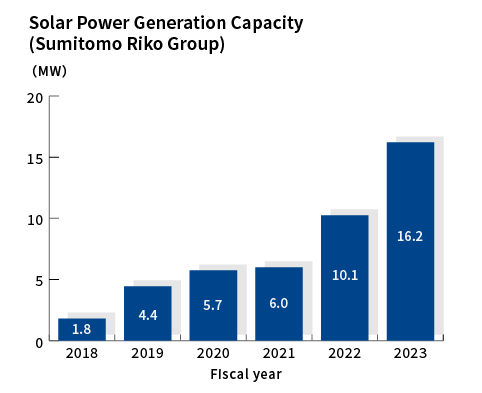

①Expansion of Solar Power
As solar power generation is a leading form of renewable energy that does not emit GHGs, the Sumitomo Riko Group is actively incorporating it into its operations. In FY2024, we installed a total of 4.9 MW of solar power generation capacity at our facilities in Japan, China, and Indonesia, bringing our cumulative generation capacity to 21.1 MW—a 1.3-fold increase compared to the previous year. Additionally, our annual emissions reduction reached 10,500 tons of CO2 equivalent.
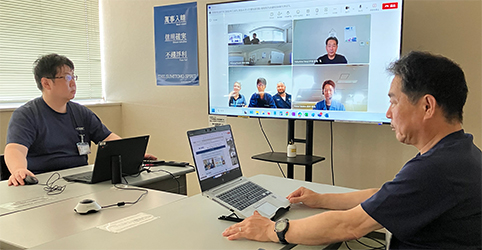
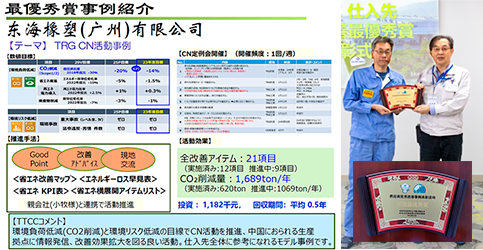
②Promotion of Global Energy Saving Activities by CN Teams
The Sumitomo Riko Group has formed Carbon Neutral (CN) teams to enhance collaboration between headquarters and manufacturing sites, aiming to effectively achieve CO2 reduction targets. In FY2024, we worked with eight teams in high CO2 emission locations, including the Komaki Plant and sites in the United States and China. Through weekly CN meetings, we shared effective energy-saving measures from the Komaki Plant, such as switching off lights and equipment when not in use, planned power outages, and addressing air and heat leakage. This resulted in an approximate reduction of 8,000 tons of CO2 annually. Notably, SumiRiko Automotive (Guangzhou) Co., Ltd. (SRK-GZ) received high recognition for its internal initiatives and the extension of these activities to other locations in China. In FY2025, we will establish CN teams in Southeast and South Asia to achieve further CO2 reductions.
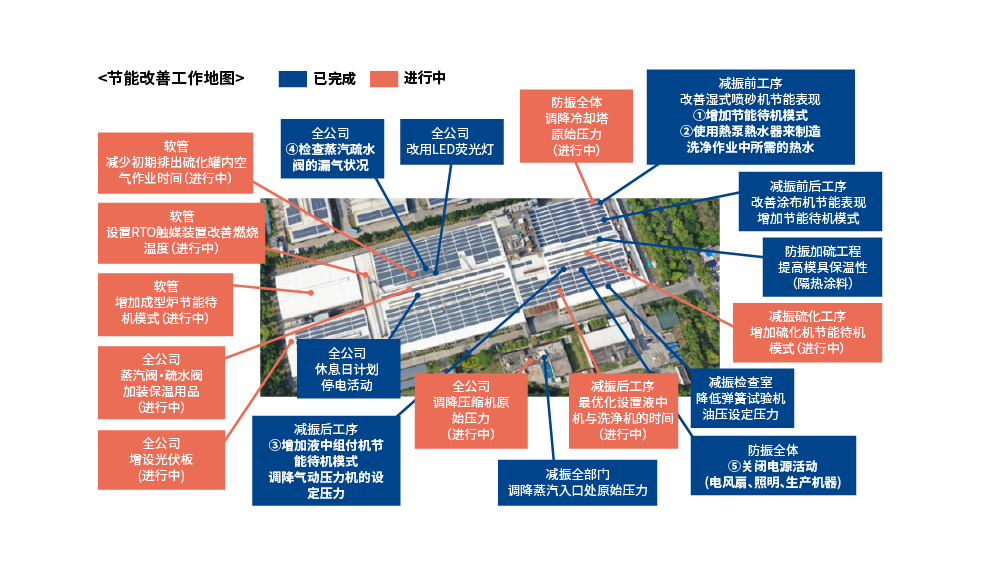
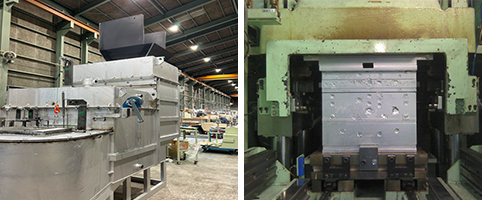
③Reduction of Heat Loss
At Sumitomo Riko, we rely on a substantial amount of thermal energy for various processes, such as vulcanizers and drying ovens, making the management of heat loss a critical priority. To address this issue, each department has proposed ideas for optimal insulation specifications for their equipment, leading to ongoing discussions, enhancements, and the implementation of effective solutions. Moreover, we actively encourage our suppliers to adopt these successful measures, which contribute to reducing emissions throughout our Scope 3 supply chain.
④Optimal Operation of the Cogeneration System
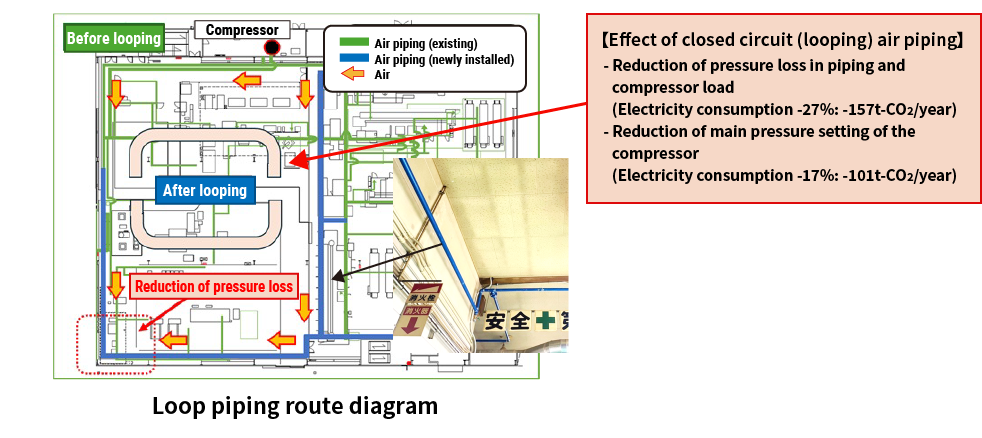
The cogeneration system (CGS) is designed to effectively utilize the heat generated during power production. In conventional power generation, this heat is wasted; however, CGS captures this heat for hot water supply and steam generation, enhancing energy efficiency and contributing to a reduction in CO2 emissions. At Komaki Plant, we have optimized the operation of our CGS in conjunction with improving boiler efficiency, resulting in a reduction of approximately 1,800 tons of CO2 emissions per year.
GHG Emissions in the Value Chain
The Sumitomo Riko Group is committed to achieving carbon neutrality by 2050. To this end, we are not only reducing GHG emissions from our own business activities (Scope 1 and 2) but also working to minimize emissions across our entire value chain (Scope 3), which includes the procurement of raw materials as well as the use and disposal of our products.
In FY2024, the breakdown of GHG emissions for the Sumitomo Riko Group across its entire value chain was 8.6% for Scope 1 and 2 combined, and 91.4% for Scope 3. Notably, Scope 3 emissions decreased by 15.0% compared to FY2018, primarily due to the adoption of sustainable materials and the expansion of products for electric vehicles.
In FY2024, the breakdown of GHG emissions for the Sumitomo Riko Group across its entire value chain was 8.6% for Scope 1 and 2 combined, and 91.4% for Scope 3. Notably, Scope 3 emissions decreased by 15.0% compared to FY2018, primarily due to the adoption of sustainable materials and the expansion of products for electric vehicles.
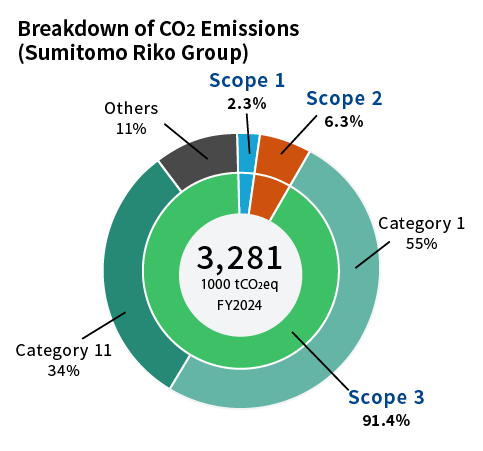
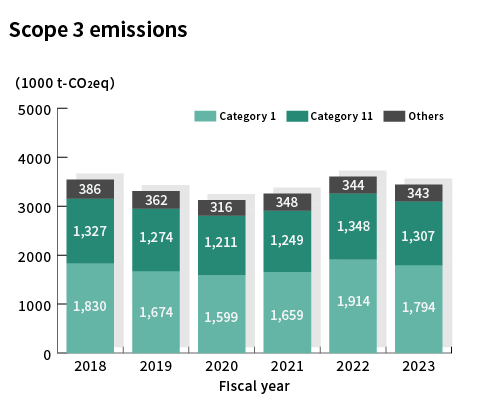
•Scope 1: 75,000 tCO2eq
•Scope 2: 206,000 tCO2eq
•Scope 3: 3,000,000 tCO2eq
Category 1 = Purchased goods and services
Category 11 = Processing of sold products
Others = Categories 2-10, 12-15
•Scope 2: 206,000 tCO2eq
•Scope 3: 3,000,000 tCO2eq
Category 1 = Purchased goods and services
Category 11 = Processing of sold products
Others = Categories 2-10, 12-15
Promotion of Modal Shift and Transportation Efficiency
At Sumitomo Riko, we are committed to reducing the environmental impact of logistics through modal shifts and shipment consolidation, which aim to decrease the number of trips by utilizing larger vehicles. Additionally, we further minimize the number of trips through route optimization, thereby further decreasing our environmental footprint.
Future Issues and Responses
In the latest global warming report published by the United Nations in March 2023 (AR6 Synthesis Report, IPCC), countries around the world are urged to make significant and rapid reductions in GHG emissions. In response, the Sumitomo Riko Group recognizes the importance of steadily advancing its current GHG reduction plan, achieving its targets ahead of schedule, and establishing new objectives.
Furthermore, in our pursuit of carbon neutrality, we will collaborate not only within our organization but also with the Sumitomo Electric Group, local businesses, and companies across various industries to address this global challenge.
Furthermore, in our pursuit of carbon neutrality, we will collaborate not only within our organization but also with the Sumitomo Electric Group, local businesses, and companies across various industries to address this global challenge.

